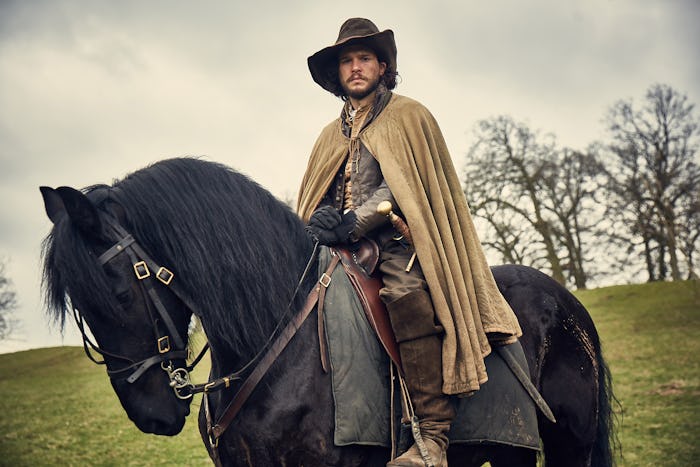Entertainment

'Gunpowder' Incorporates Some Horrifying History
Though Kit Harington's new miniseries Gunpowder already made its debut on BBC-One, it jumped across the pond to premiere on HBO on Dec. 18. American viewers might be slightly less familiar with the real events that inspired the series, making it all the more surprising that Gunpowder is based on a true story and the wild scheming within comes from actual history.
It retells the 1605 Catholic plot to kill King James I by blowing up the House of Lords, a plan conceived by Robert Catesby and aided by Guy Fawkes (who eventually got his own holiday out of the deal). Harington stars as Catesby, and his existence is actually further proof of the veracity of the story: Harington, whose full name is Christopher Catesby Harington, is actually a direct descendent of the man he's playing.
In fact, Harington had relatives on both sides of the divide. He was related to Catesby on his mother's side, but his father had ancestors in the Houses of Parliament during the same time. Perhaps it was Harington's real connection to the material that made him so insistent upon keeping it true to history — especially when it came to the goriest details.
"We did the research on how people were hung, drawn, and quartered. It was important for the story because right from the start we need to know why Robert Catesby embarks upon this very, very violent act," Harington told BBC Newsbeat. "At the time, Catholics were being persecuted and there is nothing in this which is not historically accurate. So we needed to see something quite violent from the start which makes us understand why this man might do what he does."
After Henry VIII broke with the Catholic Church and established the Church of England, Catholics faced persecution in the country. They could be exiled or executed if they refused to adhere to the Anglican Church. Though Catholics had briefly returned to power when Henry VIII's Catholic daughter Mary ascended the throne, she died shortly afterwards. Protestants were once again in control during the reigns of Elizabeth I and her successor James I.
English Catholics could face violent punishment for many reasons, including practicing their faith or hiding priests in the homes in secret compartments that came to be known as "priest holes." If discovered, it could have led to being drawn and quartered, as Harington mentioned, which involved a person being torn limb from limb after their arms and legs were tied to four different horses who were then made to run in four different directions.
At least one woman, Margaret Clitherow, was crushed to death under heavy boulders for harboring priests, something Gunpowder referenced but assigned to another, fictionalized character so that it would fit their timeline better.
It was in an attempt to stop these atrocities and restore Catholics to power in England that Catesby developed his plan, aided by a team of conspirators. However, their explosive plot ultimately did not come to pass. A warning letter was sent to the brother-in-law of one of the conspirators and it traveled down the line to the King himself. A search above and below ground at Parliament resulted in the discovery of gunpowder and a waiting Fawkes, whose job was to light the fuse that would blow everything up.
Investigation (and torture of Fawkes) exposed the rest of the men involved in the plot. Catesby was shot and killed during a last ditch effort to make a stand before being apprehended. His severed head was later displayed in front of Parliament, and the men who had aided him were violently tortured and executed.
The horrors present in Gunpowder might at times seem too shocking to be real, but it seems as though the show was faithful to what really happened.
Check out Romper's new video series, Romper's Doula Diaries:
Watch full episodes of Romper's Doula Diaries on Facebook Watch.